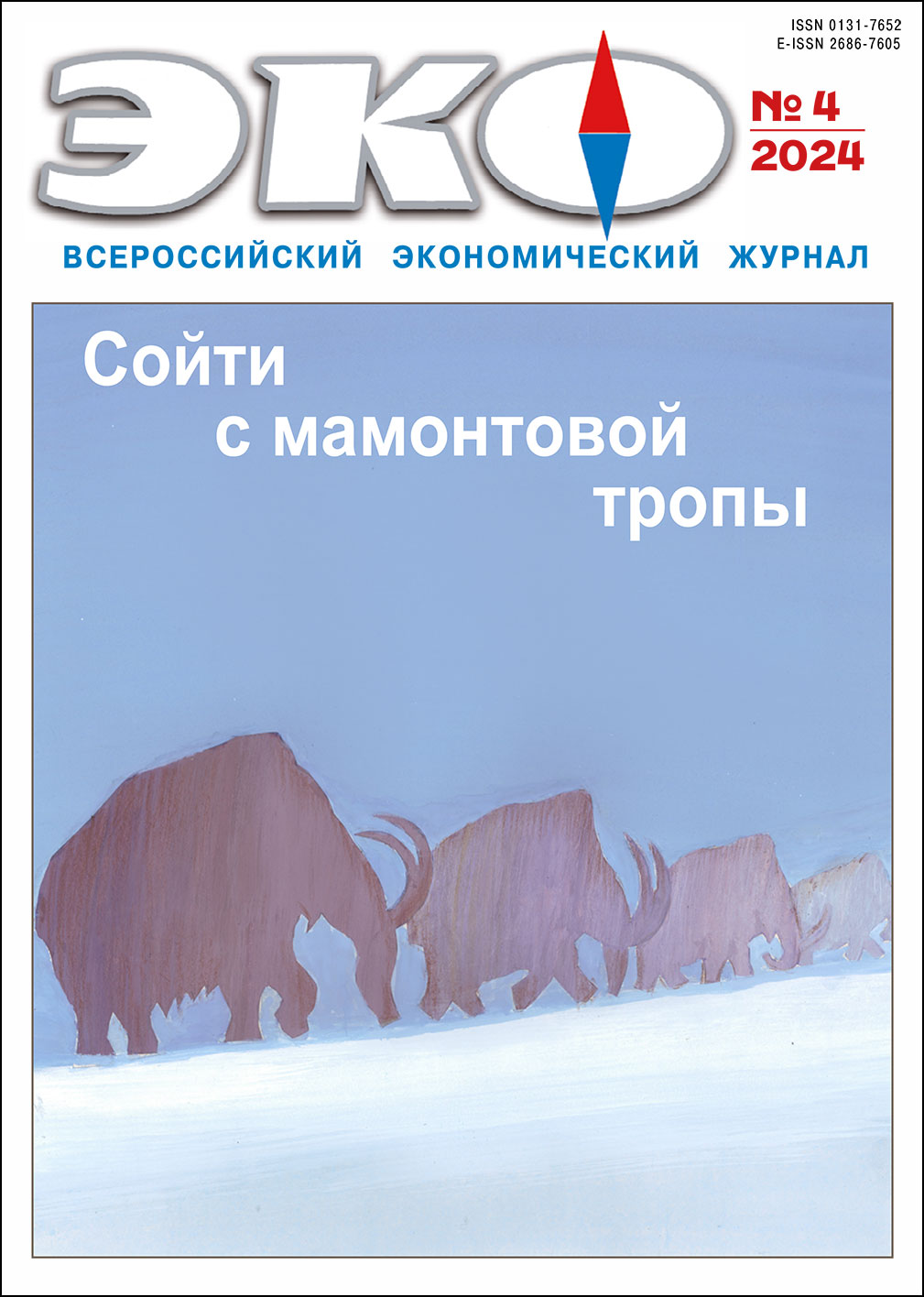Cover story: Get off the Mammoth Trail
How to Make the Business of Mammoth Fauna Extraction Work for the Development of the Region and the Well-Being of its Population
Published 2024-08-12
Keywords
- mammoth fauna; Arctic; Yakutia; economic security; shadow economy; traditional crafts; indigenous peoples of the North
How to Cite
1.
Sofronova Т, Potravnaya Е, Svintsova Т. How to Make the Business of Mammoth Fauna Extraction Work for the Development of the Region and the Well-Being of its Population. ECO [Internet]. 2024 Aug. 12 [cited 2026 Jan. 21];54(4):74-96. Available from: https://ecotrends.ru/index.php/eco/article/view/4760
Abstract
The paper considers the issues of state regulation of collection (extraction) of mammoth fauna as a type of traditional nature management in the Arctic, which currently has no legal status. It is shown that the existing gaps in the legislation have led to shadow fishing of valuable raw materials. Mechanisms of economic regulation in this sphere, from licensing of subsoil areas to the organization of a trading platform, as well as specific tools of such regulation, including the introduction of payments (the most preferable of them seems to be excise tax), are proposed. Socio-economic ways of legalization and ecologization of indigenous fisheries with the use of local resources (extraction, sale and processing of mammoth fauna) are aimed at modernization of development institutions of the Arctic territories from the point of view of reflection and protection of the interests of their inhabitants.References
- Бравина Р.И. Сбор мамонтовой кости как традиционный промысел коренного населения восточносибирской Арктики (XVII – начало XX в.) // Вестник археологии, антропологии и этнографии. 2023. № 1(60). С. 163–171. DOI 10.20874/2071–0437–2023–60–1–14
- Васильева О.В. Добыча мамонтовой кости в контексте взаимоотношений торгового капитала и коренного населения (XIX–XX вв.) // Общество: философия, история, культура. 2019. № 12(68). С. 92–98. DOI 10.24158/fik.2019.12.16
- Васильева О.В. К вопросу о возможности детерминации добычи ископаемой мамонтовой кости как традиционного природопользования // Арктика и Север. 2022. № 46 С. 205–219. DOI: 10.37482/issn2221–2698.2022.46.205
- Григорьев С.А. Добыча останков мамонтовой фауны и локальные сообщества арктических территорий Якутии в конце XX в. // Вестник археологии, антропологии и этнографии. 2021. № 3 (54). С. 239–246. DOI: 10.20874/2071–0437–2021–54–3–20
- Дьяконова А.П. Социальный портрет сборщика мамонтовой кости // Социология. 2022. № 2. С. 411–417.
- Кириллин Н.Д. Ископаемая мамонтовая кость – особый геокриогенный природный ресурс // ЭКО. 2009. № 8(422). С. 54–63.
- Крюков В.А., Крюков Я.В. Арктика – от активов в пространстве к пространству активов // Научные труды ВЭО России. 2022. № 1(233). С. 32–55. DOI: 10.38197/2072–2060–2022–233–1–32–55
- Маркова В.Н., Алексеева К.И., Неустроева А.Б., Потравная Е.В. Анализ и прогноз уровня бедности населения в Арктической зоне Республики Саха (Якутия) // Проблемы прогнозирования. 2021. № 4 (187). С. 110–122. https://doi.org/10.47711/0868–6351–187–110–122
- Ноговицын Р.Р., Софронова Т.С., Новиков А.В. Арктический фонд: возможности повышения эффективности формирования доходной базы // Север и рынок: формирование экономического порядка. 2023. № 2. С. 104–116. DOI:10.37614/2220–802X.2.2023.80.007
- Ноговицын Р.Р., Софронова Т.С., Потравная Е.В. Качество жизни коренных малочисленных народов Севера в контексте промышленного освоения Арктики (на примере Арктической зоны Якутии) // Арктика: экология и экономика. 2024. Т. 14. № 1. С. 147–157. DOI: 10.25283/2223–4594–2024–1–147–157
- Ноговицын, Р.Р., Софронова Т.С., Потравная Е.В. Оценка бюджетной обеспеченности арктических регионов в целях выравнивания доходов и повышения благосостояния населения // Проблемы прогнозирования. 2023. № 5 (200). С. 136–149. DOI: 10.47711/0868–6351–200–136–149
- Потравный И.М., Протопопов А.В., Гассий В.В. Добыча бивней мамонта как вид традиционного природопользования // Арктика: экология и экономика. 2020. № 1(37). С. 109–121. DOI: 10.25283/2223–4594–2020–1–109–121
- Смирнов А.Н., Кириллин Н.Д., Иванова Ю.В., Журилова М.А. Забытое полезное ископаемое российской Арктики – мамонтовая кость // Арктика: экология и экономика. 2016. № 1(21). С. 66–75.
- Терентьева М.А. Занятость в неформальном секторе экономики в северных регионах России // Север и рынок: формирование экономического порядка. 2023. № 4. С. 206–216. DOI:10.37614/2220–802X.4.2023.82.014
- Федорова А.Р., Слепцова А.А. Отражение образа мамонта в духовной культуре народов Якутии // Человек и культура. 2019. № 6. С. 164–170. DOI: 10.25136/2409–8744.2019.6.31072
- Федорова А.Р. Современные охотники за мамонтовым бивнем Якутии: поверья и практики взаимодействия // Ойкумена. Регионоведческие исследования. 2022. № 4 (63). С. 121–131.
- Ялбулганов А.А. Правовой режим платежей за пользование недрами и обеспечение фискальных интересов Российского государства // Право. Журнал Высшей школы экономики. 2017. № 3. С. 50–73.
- Argounova-Low, T. (2023). Sensing the Life of Material: Mammoth Ivory and Craftsmen’s Work. Sibirica. Vol. 22. No. 3. Pp. 1–21. https://doi.org/10.3167/SIB.2023.220301
- Arzyutov, D. (2019). Environmental encounters: Woolly mammoth, indigenous communities and metropolitan scientists in the Soviet Arctic. Polar Record. Vol. 55. Pp. 142–153.
- Farah, N., Boyce, J. (2019). Elephants and mammoths: the effect of an imperfect legal substitute on illegal activity. Environment and Development Economics. 1–27.
- Hill, R.¸ Adem, C., Alangui, W.V. et al. (2020). Working with Indigenous, local and scientific knowledge in assessments of nature and nature’s linkages with people. Current Opinion in Environmental Sustainability. No. 43. Pp. 8–20. https://doi.org/10.1016/j.cosust.2019.12.006
- Ivanova-Unarova, Z. I., Alekseeva, L. R. (2021). Ivory Carving in Yakutia: National Identity and Processes of Acculturation. Sibirica. No. 20(2). Pp. 76–101.
- Luzan, V. et al. (2020). History of World and Russian Mammoth Studies. Journal of Siberian Federal University. Humanities & Social Sciences. No. 13(7). Pp. 1163–1181.
- Potravnaya, E., Hye-Jin Kim. (2020). Economic Behavior of the Indigenous Peoples in the Context of the Industrial Development of the Russian Arctic: A Gender-Sensitive Approach. REGION: Regional Studies of Russia, Eastern Europe, and Central Asia. No. 9(2). Pp. 101–126.

